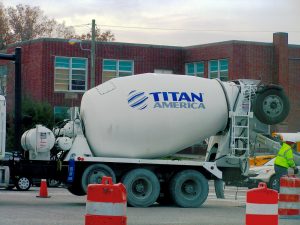1 Confined Space
First off, what is a confined space? Well, there are three things that are needed to deem a space as a Confined Space.
“Tanker Truck” by Beyond My Ken is licensed under CC BY-SA 4.0
- The space in question needs to be large enough for you to enter and do work. If you cannot enter the space to do work, you cannot put yourself in the harm of working in that space. A common confined space that everyone has seen could be a tanker truck that hauls gasoline, oil, or diesel. Can you fit in that space to do work? Yes
- The space in question is not designed for continuous human occupancy. If the space in question is designed for continuous occupancy the likely hood of serious dangers being in that space is not that great as it was designed for such use. Think of the tanker truck again. Was that space designed for continuous occupancy? No.
- The space in question has a limited means of entry and exit. Think back to the other two rules. If a space is designed for human occupancy, it is probably easy to get in and out of right? A confined space may only have one entry point and that point might be a ladder. That space would not be easy to get in and out of. Again, think about the tanker truck. Is that tanker easy to get in and out of? Does it have a door on the side? A tanker truck would fit this rule, not easy to get in and out of.
We will look at a few other “Confined Spaces” and examine them to see if they fit the rule. Always keep in mind that even though a space may not fit all three rules as a confined space does that mean you should not treat that space with the same respect and care when entering and doing work? Treat all spaces with the same level of safety in mind.

Here we have a concrete mixing truck. It is large enough to get into, has limited means of getting in and out, and is not designed for continuous occupancy. This space meets all the needs and should be deemed a confined space.
TITAN by Bill Smith is licensed under CC BY 2.0

Here is a skate bowl. This is not easy to get in and out of, is large enough to get into but it IS designed for continuous occupancy. This space meets two of the three requirements so is not a confined space.
SKATEBOWL By HEB is licensed under CC BY-SA 3.0

The last example is a water tank. This tank does have access from the top and bottom but would still not be easy to get in and out of. It is large enough to get in but it is not designed for continuous occupancy. This is a confined space and meets all three requirements.
Water Storage Tank at Carl G. Washburne Memorial State Park by Rick Obst is licensed under CC BY 2.0
There are many shapes and sizes of spaces that could be deemed as “Confined Spaces.” Be sure to consult your supervisor or safety officer and see if they meet the three requirements that make the space a true “Confined” work area.
There are other rules and requirements required to work inside a confined space but we will not cover those rules here. We will simply go over some things you may encounter while working in a confined space.
Why do we need to be so concerned about working in a confined space? There are several reasons to be concerned but we are going to concentrate and a few that will keep you thinking while working in and around these spaces.
We will look at;
Atmospheric conditions of space
What kind of work are we doing?
What was in the space?
What is the shape of the space?
What is outside of the space?
There are other elements to consider but if you have a good handle on these few, it will better prepare for more complicated situations.
Atmospheric conditions of space
What are you breathing? The normal breathing air outside is made up of approx 21 % oxygen, 78% nitrogen, and the remainder a mix of argon, carbon dioxide, and other gases in small amounts. This is the normal air we breathe when we are outside in nature, taking a walk, golfing, or sitting on the beach. What happens when we introduce heat from welding & cutting, exhaust from portable welding equipment, and then climb into a small space with no wind or ventilation? It could help create a dangerous and potentially deadly situation.
When working in a confined space it is critical that the air quality is measured accurately for its contents. This is done by a highly dedicated and calibrated instrument and properly trained personnel. The normal range needed to be allowed to enter a confined space is between 19.5% -23.5%. The reason for this is that breathing and doing work in an area with less than 19.5% O2 could be dangerous to your health and working in an area with O2 at greater than 23.5% could make fires easier started and spread. In the Pipe Trades, we often will be cutting and or welding. Both of these processes use a certain element of “fire” and we should all know that “fire” consumes oxygen. If we are already on the low end of the Oxygen range for confined space work, the cutting and welding operations could consume some of the oxygen and bring the oxygen level below permissible levels. Welding and cutting also create “off-gasses” in the form of smoke and fumes. These can also displace oxygen in the space and make breathing more difficult. This is also why it is so important to have the space monitored by someone with a calibrated instrument to check air quality.
What kind of work are we doing?
Are we inspecting the space? Are we welding and cutting? Are we bolting and wrenching? You need to fully understand what your task is before you enter the space. Not only what you are doing but what other work is going on in the space. How is your work going to impact the air quality? We talked earlier about how cutting and welding can consume and displace oxygen levels but also need to be aware that work by others in the space could also impact the ar quality. If you are doing work that involves the use of any chemicals, should be ventilated? It is good practice to always ask before entry of other work going on in the space.
What was in the space?
Is this a fuel tank? It is a wood chip bin? Is it a milk truck tank? There are a wide variety of tanks and vessels that Pipe Trade professionals can enter to perform work and we need to fully understand what is normal in the tank or vessel and what we can expect to encounter when we enter such confined spaces.
Some liquids and chemicals could create a coating onto metal surfaces in the confined space that could “Off-Gas” when heated and welding. That could create an Oxygen level issue. Some vessels may contain dry contents such as sawdust and wood chips. Fine dust particles could make breathing difficult and both dust and chips could create a fire hazard. The fire hazard no matter how small will create a higher temperature plus consume oxygen and also generate noxious fumes with smoke. Believe it or not but, you can actually take dry powder coffee creamer, sprinkle it over a candle and it will burn. The next time you enter a space that is very dusty, keep that in mind.
A good source of information on what safety measures and PPE should be used is the SDS, Safety Data Sheets for the contents of the space.
What is the shape of the space?
Is the space a basic box with a flat bottom and square walls? Does it have sloping sides and perhaps a cone-shaped bottom? Are there areas that material could be trapped or areas you could fall into?
If the confined space you are entering has any places where material could become stuck or trapped and has the ability to “rot” such as in wood products like pulp and wood chips, it could create, H2s or Hydrogen Sulfide. H2s is a very deadly gas. H2s has a very distinct odor of rotten eggs. The problem is that after a little exposure you will not be able to smell it any longer as it will temporarily shut down your ability to sense it. Prolonged exposure can cause a wide array of health issues. Air testing instruments are tuned and calibrated to sense this gas. Just as solid material can become trapped or lodged in a tank or vessel so can gasses that are heavier than air.
Knowing what was in the tank prior will help arm the information about what hidden dangers may lurk. Some gasses are heavy and will settle towards the bottom of the tank so be aware and be sure the air is being tested at all levels of the tank.
What is outside of the space?
Many times there is work going on inside of a confined space there is also work going on outside of a confined space. This work could involve equipment that is operated using gas or diesel-engine-driven generators and other equipment that can create exhaust fumes. You need to be aware that those exhaust fumes could inadvertently be pushed or could collect into the confined space you are working in. Even though the work you are doing is not generating any fumes the work outside could be. Be aware of any work near your confined space work. There could also be overhead working going on which could make getting in and out of the space hazardous if you are not paying attention.
Working in confined spaces takes lots of training for all those involved with the work being performed. This is only to make you aware of some of the very basics you should know and to make learning more about confined spaces easier.
A few important things to remember;
OSHA will always set the minimum requirements, each facility can impose stricter rules but they must meet the OSHA minimum.
You can never have too much safety training.
You can never ask a stupid question when it comes to your safety.
You should never perform a task you feel unsafe about.
You are responsible for your safety.
Some common terms you may encounter when working in and around confined spaces;
Attendant-Person stationed outside on space that monitors the air quality of space. They monitor work in space and allow access to space.
Entrant-Anyone that is authorized to enter the space to perform work inside the space.
IDLH-Immediately Dangerous to Life and Health. This is a serious condition that must be avoided and could be caused by atmospheric conditions in the space.
LEL-Lower Explosive Limit. This is the limit of a concentration of flammable vapors at which an ignition can occur. Anything below this limit is safe.
PEL’s-Permissible Exposure Limits. Regulatory limits on how much exposure is allowed depending upon what you are being exposed to.
TWA-Time Weighted Average. The amount of concentration of airborne toxins that have been averaged over an eight-hour working day.
Self Rescue-The means of being able to exit the space with no outside help when an emergency occurs.
There is no substitute for more training in regard to working in confined spaces. Always be sure you fully understand the rules of the job, the company, and the region in which you are working. Never be afraid to ask questions and stay safe.
